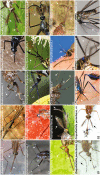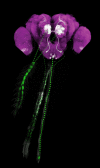Olfactory systems across mosquito species
- PMID: 33475852
- PMCID: PMC7873006
- DOI: 10.1007/s00441-020-03407-2
Olfactory systems across mosquito species
Abstract
There are 3559 species of mosquitoes in the world (Harbach 2018) but, so far, only a handful of them have been a focus of olfactory neuroscience and neurobiology research. Here we discuss mosquito olfactory anatomy and function and connect these to mosquito ecology. We highlight the least well-known and thus most interesting aspects of mosquito olfactory systems and discuss promising future directions. We hope this review will encourage the insect neuroscience community to work more broadly across mosquito species instead of focusing narrowly on the main disease vectors.
Keywords: Brain; Evolution; Mosquitoes; Neuroethology; Neurons; Olfactory organs; Receptors; Sensory ecology.
Figures


Similar articles
-
Identification of Aedes aegypti cis-regulatory elements that promote gene expression in olfactory receptor neurons of distantly related dipteran insects.Parasit Vectors. 2018 Jul 11;11(1):406. doi: 10.1186/s13071-018-2982-6. Parasit Vectors. 2018. PMID: 29996889 Free PMC article.
-
The neurobiology of insect olfaction: sensory processing in a comparative context.Prog Neurobiol. 2011 Nov;95(3):427-47. doi: 10.1016/j.pneurobio.2011.09.007. Epub 2011 Sep 24. Prog Neurobiol. 2011. PMID: 21963552 Review.
-
The olfactory basis of orchid pollination by mosquitoes.Proc Natl Acad Sci U S A. 2020 Jan 7;117(1):708-716. doi: 10.1073/pnas.1910589117. Epub 2019 Dec 23. Proc Natl Acad Sci U S A. 2020. PMID: 31871198 Free PMC article.
-
Human Odour Coding in the Yellow Fever Mosquito, Aedes aegypti.Sci Rep. 2019 Sep 16;9(1):13336. doi: 10.1038/s41598-019-49753-2. Sci Rep. 2019. PMID: 31527631 Free PMC article.
-
Insect olfactory receptors: contributions of molecular biology to chemical ecology.J Chem Ecol. 2004 Dec;30(12):2359-97. doi: 10.1007/s10886-004-7941-3. J Chem Ecol. 2004. PMID: 15724962 Review.
Cited by
-
Behavioral algorithms and neural mechanisms underlying odor-modulated locomotion in insects.J Exp Biol. 2023 Jan 1;226(1):jeb200261. doi: 10.1242/jeb.200261. Epub 2023 Jan 13. J Exp Biol. 2023. PMID: 36637433 Free PMC article. Review.
-
Screening for odorant receptor genes expressed in Aedes aegypti involved in host-seeking, blood-feeding and oviposition behaviors.Parasit Vectors. 2022 Mar 4;15(1):71. doi: 10.1186/s13071-022-05196-9. Parasit Vectors. 2022. PMID: 35246203 Free PMC article.
-
Impact of elevated CO2 level and egg quiescence duration on gene expression in the peripheral olfactory system of Aedes aegypti.Sci Rep. 2025 Apr 24;15(1):14318. doi: 10.1038/s41598-025-98159-w. Sci Rep. 2025. PMID: 40275031 Free PMC article.
-
In vitro larvicidal activity of selected azabenzimidazole and diarylquinoline derivatives against Anopheles gambiae and in silico mechanistic analysis.Mol Divers. 2025 Apr 10. doi: 10.1007/s11030-025-11189-4. Online ahead of print. Mol Divers. 2025. PMID: 40210815
-
The Perpetual Vector Mosquito Threat and Its Eco-Friendly Nemeses.Biology (Basel). 2024 Mar 12;13(3):182. doi: 10.3390/biology13030182. Biology (Basel). 2024. PMID: 38534451 Free PMC article. Review.
References
Publication types
MeSH terms
LinkOut - more resources
Full Text Sources
Other Literature Sources

